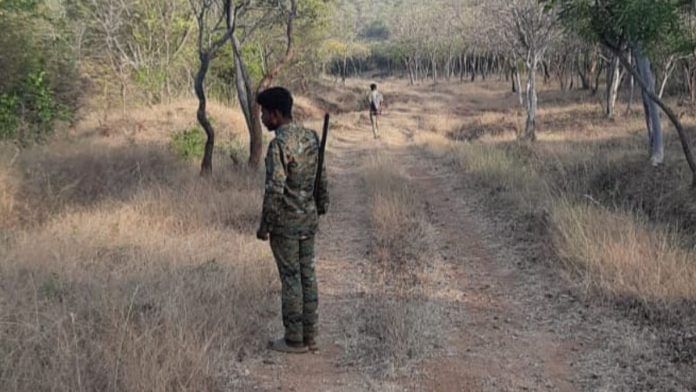Bengaluru: A mutilated tiger’s body was found at the Male Mahadeshwara Sanctuary in Chamarajanagar, Karnataka, on Tuesday. With this, six tigers have been victims of alleged poaching this year. The latest incident in Hanur Range near Pachchedoddi village has triggered alarm across conservation circles as the sanctuary has been ‘slowly becoming a burial ground for tigers’.
The forest department staff on 2 October were on their routine beat patrol when they stumbled upon a grim sight—part of a tiger’s carcass buried under soil. The recovered remains included the head, shoulders, and front legs, while the rest of the body was missing. The portions found still had claws and teeth intact, pointing towards possible poaching. Previously this year, five tiger deaths have been reported in the PG Palya Range of the sanctuary.
Prima facie, it appeared to be an unnatural death, the Range Forest Officer (RFO) of Hanur said, adding, “We are suspecting either a gunshot or poisoning. Only after a detailed postmortem and forensic examination will the exact cause be confirmed.” The Forest Department registered a case and launched an investigation, seeking assistance from Scene of Crime (SoCo) officers, dog squads, and technical units to secure evidence.
High-level probe ordered
Taking serious note of the incident, Forest, Ecology, and Environment Minister Eshwar B Khandre expressed deep shock at the incident, which had occurred on the first day of Wildlife Week. He has directed a Principal Chief Conservator of Forests (PCCF)-led team under Smita Bijjur to investigate the incident. Additionally, a written order has also been issued to the Additional Chief Secretary over a thorough probe into the matter.
The minister has instructed the team to examine the latest case and review all the past poaching incidents recorded in Male Mahadeshwara Hills (MM Hills) over the last three years. He has ordered the committee to revisit earlier investigation reports, identify lapses, and recommend action against negligent officials, as well as pursue strict legal measures against poachers. The team has been asked to submit its findings within eight days and ensure that the culprits are brought to justice at the earliest.
Also read: Jane Goodall—no formal degree, no laboratory, only passion for the wild
A pattern of neglect
Sources from within the department say the killings reflect deeper systemic failures. “The lack of regular foot patrolling and ground presence is creating opportunities for poachers. In several beats, staff shortages and weak supervision have left critical gaps,” a former Karnataka PCCF said.
Conservationists note that despite repeated proposals to notify MM Hills as a Tiger Reserve, regional political tussles have stalled its declaration. Without Tiger Reserve status, the sanctuary lacks the funding, staffing, and institutional mechanisms necessary for stronger protection.
Khandre, however, has emphasised that stringent measures will be taken to prevent such incidents from recurring.
Wildlife experts warn that unless urgent measures—ranging from enhanced patrolling to stricter anti-poaching intelligence networks—are implemented, MM Hills may lose its chance to be recognised as a viable tiger landscape.
For now, investigations are underway. But in the forests of MM Hills, the death of yet another tiger lies heavy, a stark reminder that one of Karnataka’s most critical wildlife habitats is under siege, and political indecision is costing big cats their lives.
Tejus RS is an intern from ThePrint School of Journalism.
(Edited by Saptak Datta)






